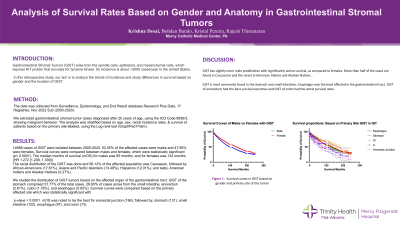Monday Poster Session
Category: Stomach
P2750 - Analysis of Survival Rates Based on Gender and Anatomy in Gastrointestinal Stromal Tumors (GIST)
Monday, October 23, 2023
10:30 AM - 4:15 PM PT
Location: Exhibit Hall

Has Audio

Krishna Desai, MD
Mercy Catholic Medical Center
Philadelphia, PA
Presenting Author(s)
Krishna Desai, MD1, Bohdan Baralo, MD1, Kristal N. Pereira, MD1, Rajesh Thirumaran, MD2
1Mercy Catholic Medical Center, Philadelphia, PA; 2Mercy Catholic Medical Center, Darby, PA
Introduction: Gastrointestinal Stromal Tumors (GIST) arise from the spindle cells, epitheloid, and mesenchymal cells, which express KIT protein that encodes for tyrosine kinase. Its incidence is about ~5000 cases/year in the United States. In this retrospective study, our aim is to analyze the trends of incidence and study differences in survival based on gender and the location of GIST.
Methods: The data was collected from Surveillance, Epidemiology, and End Result database Research Plus Data, 17 Registries, Nov 2022 Sub (2000-2020). We extracted gastrointestinal stromal tumor cases diagnosed after 20 years of age, using the ICD Code 8936/3, showing malignant behavior. The analysis was stratified based on age, sex, racial incidence rates, & survival of patients based on the primary site-labeled, using the Log-rank test (GraphPad Prism).
Results: 14688 cases of GIST were isolated between 2000-2020. 52.05% of the affected cases were males and 47.95% were females. Survival curves were compared between males and females, which were statistically significant (p< 0.0001). The median months of survival (mOS) for males was 95 months, and for females was 134 months (HR 1.272 [1.208, 1.339]). The racial distribution of the GIST was done and 56.12% of the affected population was Caucasian, followed by African-Americans (17.61%), Asians and Pacific Islanders (13.48%), Hispanics (12.01%), and lastly, American Indians and Alaskan Natives (0.27%). We studied the distribution of GIST tumors based on the affected organ of the gastrointestinal tract. GIST of the stomach comprised 57.77% of the total cases. 26.60% of cases arose from the small intestine, anorectum (2.61%), colon (1.76%), and esophagus (0.62%). Survival curves were compared based on the primary affected site which was statistically significant with p-value < 0.0001. mOS was noted to be the best for anorectal junction (166), followed by, stomach (131), small intestine (122), esophagus (97), and colon (73).
Discussion: GIST has slightly more male predilection with significantly worse survival, as compared to females. More than half of the cases are found in Caucasians and the rarest in American Indians and Alaskan Natives. GIST is most commonly found in the stomach and small intestines. Esophagus was the least affected in the gastrointestinal tract. GIST of anorectum had the best survival outcomes and GIST of colon had the worst survival rates.

Disclosures:
Krishna Desai, MD1, Bohdan Baralo, MD1, Kristal N. Pereira, MD1, Rajesh Thirumaran, MD2. P2750 - Analysis of Survival Rates Based on Gender and Anatomy in Gastrointestinal Stromal Tumors (GIST), ACG 2023 Annual Scientific Meeting Abstracts. Vancouver, BC, Canada: American College of Gastroenterology.
1Mercy Catholic Medical Center, Philadelphia, PA; 2Mercy Catholic Medical Center, Darby, PA
Introduction: Gastrointestinal Stromal Tumors (GIST) arise from the spindle cells, epitheloid, and mesenchymal cells, which express KIT protein that encodes for tyrosine kinase. Its incidence is about ~5000 cases/year in the United States. In this retrospective study, our aim is to analyze the trends of incidence and study differences in survival based on gender and the location of GIST.
Methods: The data was collected from Surveillance, Epidemiology, and End Result database Research Plus Data, 17 Registries, Nov 2022 Sub (2000-2020). We extracted gastrointestinal stromal tumor cases diagnosed after 20 years of age, using the ICD Code 8936/3, showing malignant behavior. The analysis was stratified based on age, sex, racial incidence rates, & survival of patients based on the primary site-labeled, using the Log-rank test (GraphPad Prism).
Results: 14688 cases of GIST were isolated between 2000-2020. 52.05% of the affected cases were males and 47.95% were females. Survival curves were compared between males and females, which were statistically significant (p< 0.0001). The median months of survival (mOS) for males was 95 months, and for females was 134 months (HR 1.272 [1.208, 1.339]). The racial distribution of the GIST was done and 56.12% of the affected population was Caucasian, followed by African-Americans (17.61%), Asians and Pacific Islanders (13.48%), Hispanics (12.01%), and lastly, American Indians and Alaskan Natives (0.27%). We studied the distribution of GIST tumors based on the affected organ of the gastrointestinal tract. GIST of the stomach comprised 57.77% of the total cases. 26.60% of cases arose from the small intestine, anorectum (2.61%), colon (1.76%), and esophagus (0.62%). Survival curves were compared based on the primary affected site which was statistically significant with p-value < 0.0001. mOS was noted to be the best for anorectal junction (166), followed by, stomach (131), small intestine (122), esophagus (97), and colon (73).
Discussion: GIST has slightly more male predilection with significantly worse survival, as compared to females. More than half of the cases are found in Caucasians and the rarest in American Indians and Alaskan Natives. GIST is most commonly found in the stomach and small intestines. Esophagus was the least affected in the gastrointestinal tract. GIST of anorectum had the best survival outcomes and GIST of colon had the worst survival rates.

Figure: Survival curves in GIST based on gender and primary site of the tumor
Disclosures:
Krishna Desai indicated no relevant financial relationships.
Bohdan Baralo indicated no relevant financial relationships.
Kristal Pereira indicated no relevant financial relationships.
Rajesh Thirumaran indicated no relevant financial relationships.
Krishna Desai, MD1, Bohdan Baralo, MD1, Kristal N. Pereira, MD1, Rajesh Thirumaran, MD2. P2750 - Analysis of Survival Rates Based on Gender and Anatomy in Gastrointestinal Stromal Tumors (GIST), ACG 2023 Annual Scientific Meeting Abstracts. Vancouver, BC, Canada: American College of Gastroenterology.
